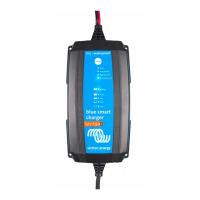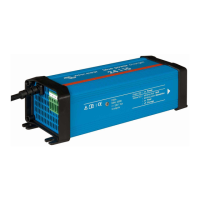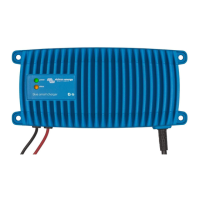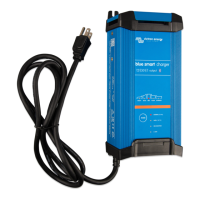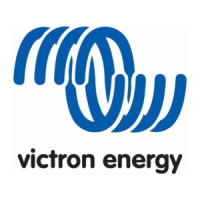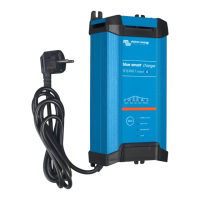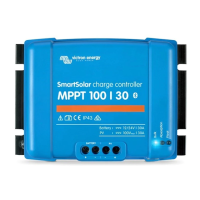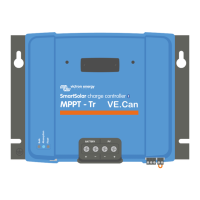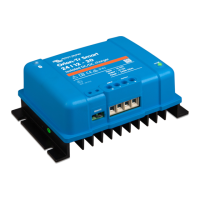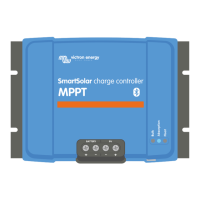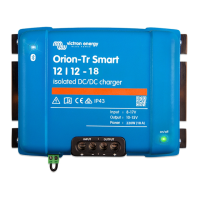
Do you have a question about the Victron energy BlueSolar 100/30 and is the answer not in the manual?
| Model | BlueSolar 100/30 |
|---|---|
| Type | MPPT Solar Charge Controller |
| Category | Battery Charger |
| Maximum PV Open Circuit Voltage | 100V |
| Maximum Charge Current | 30 A |
| Charge voltage 'absorption' | 14.4 V / 28.8 V |
| Charge voltage 'float' | 13.8 V / 27.6 V |
| Efficiency | Up to 98% |
| Communication Port | VE.Direct |
| Maximum PV Power | 440W (12V), 880W (24V) |
| Battery Voltage | 12/24V (Auto Select) |
| Operating Temperature Range | -30°C to +60°C |
| Protection | Reverse polarity |
| Temperature Compensation | -16mV / °C / 12V battery (-32mV / °C / 24V battery) |
Read manual carefully for important installation, operation, and maintenance instructions.
Guidelines for using appropriate cables and ensuring safe electrical connections, emphasizing stranded copper and proper gauge.
Details the solar charger's capabilities for charging batteries from PV arrays, specifying voltage and current limits.
Explains how the solar charger automatically detects and adapts to 12V, 24V, or 48V system voltages upon initial power-up.
Highlights the ultra-fast MPPT controller for maximizing energy harvest, especially in changing light conditions.
Details the high conversion efficiency, exceeding 98%, enabling fanless operation up to 40°C.
Covers the built-in protections against over-temperature, PV reverse polarity, and PV reverse current.
Describes the VictronConnect App's functionality for monitoring, operating, accessing data, and configuring the solar charger.
Lists the available display options for monitoring the solar charger's status and data.
Explains the VE.Direct port's purpose for communication, data transfer, and external control, detailing required cables.
Details the solar charger's battery charging process, including adaptive 3-stage charging and flexible charge algorithms.
Explains temperature sensing for compensated charging, covering internal and external sensor options.
Describes the built-in internal temperature sensor used for temperature-compensated charging and overheat detection.
Explains the use of Smart Battery Sense for accurate battery temperature and voltage measurements for improved charging.
Details how optional sensors measure battery voltage to compensate for cable voltage losses.
Explains how to create a virtual remote on/off terminal using a VE.Direct cable for external control.
Describes the optional MPPT WireBox for protecting terminals and enhancing safety.
Provides instructions on how to mount the solar charger vertically, considering clearance and proximity to the battery.
Specifies battery protection requirements, fuse ratings, and cable connection guidelines.
Outlines requirements for PV array configuration, including voltage limits and panel connection types.
Explains grounding procedures for the battery, chassis, and PV array to ensure system safety.
Details the correct sequence for making electrical connections, including battery, communication, and PV array.
Guides on connecting the optional MPPT Control display using a VE.Direct cable.
Introduces methods for changing settings, including VictronConnect App, rotary switch, and MPPT Control display.
Explains how to access and modify solar charger settings using the VictronConnect mobile application.
Describes how to select pre-programmed battery charge algorithms using the rotary switch.
Details how to configure charger settings using the optional MPPT Control display.
Provides a comprehensive explanation of all user-configurable solar charger settings and firmware updates.
Covers battery voltage, max charge current, charger enable, and battery preset configurations.
Configures load output operation modes and streetlight settings for controlling external devices.
Enables automatic control of night lighting based on sunset and sunrise, with timer programming options.
Configures the TX port for sending signals to external devices, such as PWM dimming for streetlights.
Configures the RX port for receiving signals from external devices, such as BMS for remote on/off control.
Provides steps to check and update the solar charger's firmware using the VictronConnect App.
Explains the VE.Smart network for wireless data sharing via Bluetooth between Victron products.
Guides on setting up new VE.Smart networks and joining existing ones for device communication.
Explains the meaning of LED indicators for operational status, charge stages, and fault conditions.
Lists error codes displayed by the charger and directs users to the appendix for detailed meanings.
Details how to monitor the solar charger, its historical data, and operational warnings using the VictronConnect App.
Describes the status screen displaying live charger information, solar output, and battery status.
Explains how to view historical data over 30 days, including solar yield, Pmax, Vmax, and battery status.
Details how VictronConnect displays active and historical errors, including error numbers and descriptions.
Explains how to monitor the charger via a GX device and the VRM portal for remote access and alerts.
Guides on troubleshooting why the solar charger is not powering up or communicating.
Recommends checking for mechanical damage, burn marks, or water damage on the solar charger unit.
Details how to check for battery supply at the charger terminals using a multimeter.
Lists potential reasons why the solar charger may not be charging the batteries and steps to resolve.
Explains the consequences of incorrect battery cable connections and the lack of reverse polarity protection.
Describes signs of reverse PV polarity, where the controller may not indicate an error but stop charging.
Explains how the charger behaves when the battery is full, reducing charge current or stopping.
Instructs to check the VictronConnect App to ensure the charger is enabled and not manually disabled.
Details the PV voltage requirements for initiating and maintaining charging.
Ensures the 'battery voltage' setting in VictronConnect matches the actual system voltage.
Explains how external devices can control the solar charger's charge current.
Troubleshoots issues related to battery connection, fuses, circuit breakers, and cable integrity.
Addresses reasons for undercharged batteries, including low PV yield, high DC load, and incorrect settings.
Explains how excessive DC load can prevent batteries from charging, even with available PV power.
Ensures battery charge voltages are set correctly to achieve a full charge.
Describes charger behavior when batteries are nearly full, reducing current and moving to float stage.
Explains how voltage drop in battery cables can lead to undercharged batteries and how VE.Smart helps.
Emphasizes equal ambient temperatures for accurate temperature-compensated charging.
Investigates causes of insufficient solar yield, such as undersized arrays or excessive load.
Highlights the importance of correct temperature compensation coefficients to avoid under/overcharging.
Checks the 'Max charge current' setting to ensure adequate charging time and full charge.
Warns about dangers of overcharging and lists causes like incorrect voltages or unsuitable equalization.
Ensures the 'battery voltage' setting is correct to prevent overcharging, especially after system changes.
Checks if battery charge voltages are set correctly to prevent overcharging.
Warns that unsuitability for equalization can lead to overcharging, especially for sealed or lithium batteries.
Explains how old or faulty batteries can lead to overcharging of remaining cells.
Covers remaining potential solar issues not discussed earlier, such as reverse current and low yield.
Addresses high PV reverse current, potential damage from reverse polarity, and warranty considerations.
Diagnoses reasons for lower-than-expected PV yield by checking history and potential issues.
Identifies reasons for not reaching full rated output, including undersized PV arrays and high temperatures.
Explains how battery voltage affects the maximum PV output power achievable by the charger.
Recommends using only the same brand, type, and model of PV panels for optimal performance.
Discusses causes of burned or melted PV connections, often due to incorrect wiring or cable types.
Refers to the Wiring Unlimited book for detailed guidance on MC4 connector installation.
States that solar optimisers interfere with the MPPT algorithm and should not be used.
Notes the absence of internal earth fault detection and recommends external devices.
Discusses investigating ground currents and the importance of a single ground connection point.
Addresses problems arising from connections to VictronConnect App, other devices, or third-party systems.
Refers to the VictronConnect manual for comprehensive troubleshooting of the app itself.
Troubleshoots common VE.Direct communication problems related to cables, ports, and settings.
Directs users to the Smart Network manual for troubleshooting wireless communication issues.
Provides steps to diagnose and resolve Bluetooth connectivity issues, checking range and settings.
Covers issues arising from incorrect settings or outdated firmware, guiding on resolution steps.
Advises checking all settings for correctness and suggests resetting to defaults if issues persist.
Notes that not all chargers support 36V/48V, and the VictronConnect App displays supported voltages.
Recommends updating firmware to resolve potential bugs and ensure optimal performance.
States that interrupted firmware updates are recoverable by retrying the update process.
Addresses remaining operational issues not covered elsewhere, such as power supply or DC-DC charging limitations.
Discourages use as a power supply without batteries, noting potential load compatibility issues.
Advises against using the charger as a DC-DC converter, citing potential damage risks.
Provides detailed dimensional drawings for the MPPT 100/30 solar charger.
Provides detailed dimensional drawings for the MPPT 100/50 solar charger.
Lists and explains all possible error codes generated by solar or AC chargers.
Presents detailed technical specifications for the MPPT 100/30 and 100/50 models.
